|
ManageEngine® Applications Manager Enterprise Edition - Failover Support | ||
Follow the steps below to implement failover support in ManageEngine Applications Manager:
The setup involves a primary Applications Manager, a secondary Applications Manager and a common database. The primary and secondary Applications Manager refer to the common database only. While the primary Applications Manager talks with the database, the secondary Applications Manager simply listens to the database. If the primary server goes down, the secondary server takes over. Afterwards, the initial primary server is restarted and it starts functioning as a secondary server.
Let us assume we are going to set up three nodes - node1, node2
and node3.
Applications Manager: node1, node2
MSSQL Database: node3

Step 1: Install MSSQL database Server in node3 and make sure MSSQL Server is started in node3. Create the database with the name AMDB which is the database name used in Applications Manager by default.(You can change the name as you wish).
Step 2: Install Applications Manager in node1. While installing, make sure you select the database as MSSQL and give the same DB name, port number as in Step1. Start the Applications Manager in node1, this will act as the primary server. Check in the wrapper.log
Step 3: Install the Applications Manager in node2. While installing, make sure you select the database as MSSQL and give the same DB name, port number as in Step1. Start the Applications Manager in node2. Check in the wrapper.log
When node1Applications Manager goes down, node2Applications Manager will act as secondary server.
Sample Nohup Output
INFO | jvm 1 | 2013/08/05 01:00:06 | Checking for the availablity of the Primary Server in the Database. Found an Note: Above steps need to be implemented for each installation in the Enterprise setup for failover. |
Enterprise Edition - Single Sign-On |
Enterprise Edition - Failover Support |